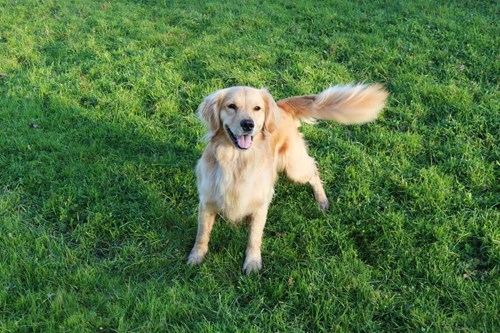8/8/2024
Tail Talk: What Your Dog’s Tail Can Tell You About Their Feelings

Ever wondered what your dog's tail is trying to tell you?
Dogs may not speak our language, but with the help of their tails, dogs have another way to communicate. Understanding dog tail movements and placement can give you valuable insights into your pup's emotions and well-being.
The Basics of Dog Tail Signals
A dog’s tail is more than just an adorable appendage – it’s a communication tool. The way your furry friend instinctively holds their tail or the rate at which they wag it are good indicators of happiness, anxiety, and many other emotions.
When evaluating your four-legged friend’s tail signals, it’s important to keep in mind that some dogs are easier to evaluate than others. Dogs with big, long tails make tail wag decoding fairly easy, breeds that have shorter or curled tails aren’t quite as simple to read. These differences can make it harder to figure out their body language, but as you spend more time with these dogs, you’ll slowly become an expert at identifying the various stub wiggles of corgis, bulldogs, and other similar breeds
Dog Tail Meaning: Movement

Tail wags can stand for a variety of moods ranging from joy to anxiety. There are several types of tail wags that can help you identify how your furry friend feels at any given moment.
Full Body Tail Wag
If your dog greets you with their tail swaying from side to side, they’re probably happy to see you. Big, broad strokes of the tail – especially when paired with a slight bow of the head and sway of the hindquarters – is typically a good sign that your dog is quite pleased, whether it’s because you just arrived home or you have a tasty dog treat in your hand.
Fast Tail Wag
Your dog can show excitement about something with a fast-moving, twitchy tail, but it can also be a sign of agitation depending on the circumstances. For example, your four-legged best friend’s tail might wag like crazy if you just returned home after a long trip. However, a dog who doesn’t know you in the park may display rapid, short tail movements to display that they’re not familiar with you, and they are prepared to go on the defensive if necessary.
Slow Tail Wag
In general, a slow, hesitant wag is a sign that a dog is nervous or unsure about something. This is pretty typical for more submissive dogs when they encounter new people, animals, or even large objects.
Wags to One Side
One study suggests that the direction of a wag can be a sign of what a dog thinks. Based on this, a tail wagging more to the right side is a sign of a relaxed dog, whereas the left side could be a sign of stress or anxiety.
Stiff Tail
No motion can be another indicator of a dog’s mood. A stiff tail can convey a sense of tension or alertness, such as when a dog hears an unknown noise in the backyard and looks to identify it. A stiff tail can also act as a warning that the dog is on high alert about a potential threat. Other warning signs are raised fur or narrowed eyes.
Dog Tail Meaning: Placement

Where your dog holds their tail can mean as much as how it moves. Different tail placements can convey different meanings, but you can generally group them into three different categories.
Tail is Up
When dogs hold their tails high, it’s typically a sign of alertness, dominance, or confidence. A high, still tail shows others that your four-legged friend feels like the top dog and isn’t afraid to show it. A high wag is a sign that your dog is cautiously optimistic, but ready for whatever happens.
This show of alertness isn’t always a friendly gesture. If you’re near a dog you don’t know, a high tail might mean that they’re aware of you and trying to show you their dominance.
Tail is Down
In general, a low tail indicates that a dog is nervous or timid. This is especially true if the tail is starting to curl between a dog’s legs. A low tail can even indicate that they’re afraid. If a dog’s tail is down, avoid sudden movements or other actions that may startle them.
Tail is Horizontal to the Ground
Appropriately, a tail that’s generally horizontal to the ground signifies a more neutral attitude for a dog. This action typically means your dog is curious about something or in the process of exploring.
More to Consider: Ear Placement and Body Language

Understanding dog tail signals can do wonders for strengthening the bond between you and your furry friend. Luckily for us, there are a few more signals we can look out for to help us understand our best buds and keep them happy and healthy.
Relaxed Ears and Loose Body:
- Ears: Soft, relaxed, and in a natural position.
- Body Language: When your dog’s body appears loose and wiggly, this is a good sign they are happy, relaxed, and comfortable. They might also have a soft, open mouth with a gentle pant and their eyes will appear calm. You’ll most likely see this behavior when your dog is playing, being petted, or simply relaxing with their best friend.
Ears Pinned Back and Stiff Body:
- Ears: Flattened back against the head.
- Body Language: This may indicate your dog is feeling scared, anxious, or submissive. You'll notice their body might be crouched low to the ground, showing they are trying to make themselves appear smaller to avoid confrontation. They may avoid eye contact, and you might see the whites of their eyes, known as "whale eye." This posture is common in stressful situations like thunderstorms, vet visits, or encountering a dominant dog.
Forward Ears and Stiff Legs:
- Ears: Perked up and facing forward.
- Body Language: A stiff, alert posture indicates your dog is on high alert. This stance is often seen when your dog is protecting their territory, encountering a perceived threat, or feeling dominant. Their body will be rigid, with a forward-leaning posture, and their mouth might be closed, paired with an intense stare. These signs show your dog is ready to take action if necessary.
A Different Story with Every Tail

While the information above is a great guide to help you better understand canine body language, it’s essential to consider the whole picture when interpreting dog tail signals. As with people, individual dogs vary greatly in personality which can impact their tail movement and position.
A wagging tail isn’t always a sign of friendliness, and a tucked tail doesn’t always mean fear. Look at your dog’s overall body language, including their ears, eyes, and posture to get a complete understanding of their feelings
Understanding your dog’s tail signals isn’t just about decoding wags and positions; it’s about building a deeper connection with your beloved pet. Want to identify other ways to help you keep your best friend happy and healthy? Join our Best Friends Club to receive special tips and articles on how to care for your dog, as well as members-only discounts on Bil-Jac products.







